|
|||||
|
|||||
|
|
|||||
|
|||||
|
|
from http://en.wikipedia.org/wiki/Screenshot as of 16-Oct-2013:
"A ... screenshot (or screen shot) ... is an image taken by the computer user to record the visible items displayed on the monitor, television, or another visual output device. Usually, this is a digital image using the (host) operating system or software running on the computer, but it can also be a capture made by a camera or a device intercepting the video output of the display (such as a DVR). That latent image converted and saved to an image file such as to JPEG or PNG format is also called a screenshot.
"Screenshots can be used to demonstrate a program, a particular problem a user might be having, or generally when display output needs to be shown to others or archived. ..."
In Dr.Explain, a screenshot is the "central" image in a screenshot layout page. Usually it is indeed a screenshot from a Windows software application. But it doesn't have to be. See Terminology Clarification below.
|
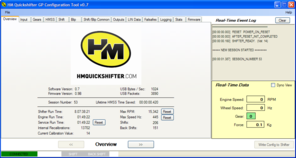 A Screenshot
|
|
"In publishing, a call-out or callout is a short string of text connected by a line, arrow, or similar graphic to a feature of an illustration or technical drawing, and giving information about that feature. The term is also used to describe a short piece of text set in larger type than the rest of the page and intended to attract attention.
"A similar device in word processing is a special text box with or without a small "tail" that can be pointed to different locations on a document."
In Dr.Explain, a callout is an artifact added to a screenshot image (added automatically or manually) which consists of:
|
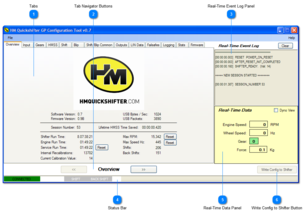 A Screenshot with Callouts
|
|
The term control is usually reserved to name a part of a Windows application that the user interacts with. Examples of controls are: buttons, text boxes, drop downs, checkboxes, etc.
However, note carefully that Dr.Explain (and the Dr.Explain Help file) sometimes uses the term control in an unusual way, and it is important to understand this to prevent confusion: sometimes Dr.Explain uses the term control to refer to a callout.
|
Examples of Controls
|
|
A control area defines the area of the screenshot that its owning callout is calling attention to. This control area is usually a rectangle, and it usually encapsulates the image of a control in the screenshot. But it doesn't have to. See Terminology Clarification below.
|
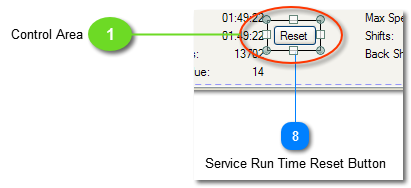 Control Area
|
|
One of Dr.Explain's main features is that it has two types of layouts for documentation pages you create. One of them is a regular HTML layout page where a WYSIWYG editor provides most of the commonly-used layout features available in HTML.
To add a page (topic) with this type of layout, place focus on the parent node in the table-of-contents tree (the node that will "contain" the new page) and click the Add Topic button in the main toolbar, or select Options > Add Topic from the menu. In these articles, I call this layout type a "basic layout". An example of a basic layout is this page. The icon for a basic layout page in the table-of-contents tree looks like a sheet of paper.
|
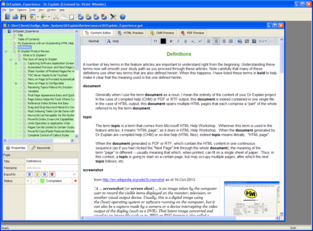 Screenshot of a Page with Basic Layout
|
|
The second type of layout, which I am calling the screenshot layout, builds on top of the basic layout, and adds some extremely useful automation to it. Specifically, in this type of layout, a "central" image exists (called a screenshot), and that image can contain a virtually unlimited quantity of numbered callouts (zero or more), and for each such callout, a section is automatically created on that page, in numerical sequence below the main image, for detailed documentation of what the callout is calling attention to -- whatever image is encapsulated in its control area. In that section, the number (a.k.a. bullet mark), name, and sub-image the control area defines, is automatically displayed in the upper left corner of that section, ready for you to add the detailed description for that callout.
To add a page (topic) with this type of layout, place focus on the parent node in the table-of-contents tree (the node that will "contain" the new page) and click the Capture window button in the main toolbar (or one of its derivatives in the drop-down menu that drops down from that button), or select Options > Add Window from the menu (or one of its derivatives in the same section on the Options menu). An example of a typical screenshot layout page is Screenshot Example 2 -- Massaged. The icon for such a page in the table-of-contents tree looks like a sheet of paper with a small software application window on top of it.
The automation added to screenshot layouts starts with the fact that for each callout added to the screenshot image, a section is reserved on the same page for detailed documentation connected with that callout. However, it doesn't stop there: Dr.Explain provides automation that, when you are documenting a running Windows software application, can create most of the screenshot layout page for you. It is here that Dr.Explain provides one of its most powerful features: if you employ Dr.Explain to capture the screenshot from a running application, it actually analyzes the window (or window portion) being captured and automatically creates callouts for most of the controls in the captured area. This means that often all you have to do to finish such a screenshot layout page page, is adjust the callouts as you see fit, delete callouts you don't need, and add the detailed descriptions to the callout sections below the screenshot. And you're done!
|
 Screenshot of a Page with Screenshot Layout
|
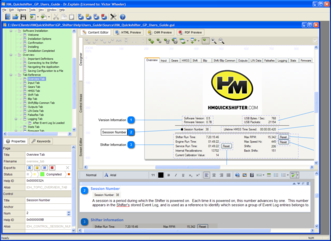 Screenshot of a Page with
Screenshot Layout in "Edit Mode"
|
|
Note carefully: while using Dr.Explain to create documentation, especially when documenting Windows software applications, the screenshots in screenshot layout pages will indeed often be screenshots from the software application being documented. However, they don't have to be. In fact, they can be almost any image that can be displayed on a computer. Thus, the screenshot in a screenshot layout page may be a diagram, an electronics schematic, an X-ray image, a photograph, an "exploded parts" view of a product, or virtually anything at all that you want to document. This is possible because screenshot layout pages can also be added (or replaced) with an image from another captured screen, an image contained in a file, or from the Windows clipboard. Thus the possibilities are almost limitless.
|
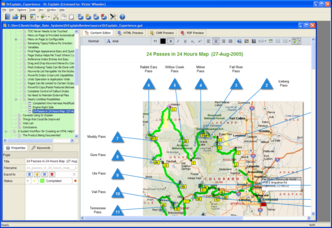 Map with Callouts as "The Screenshot"
on Screenshot Layout Page
|
